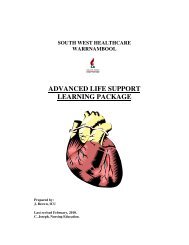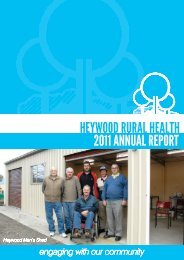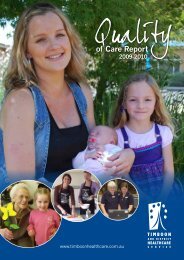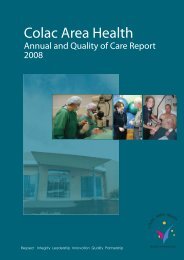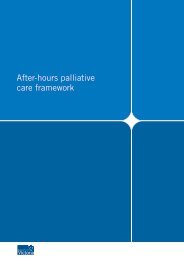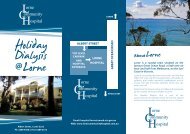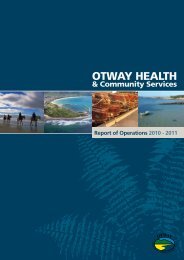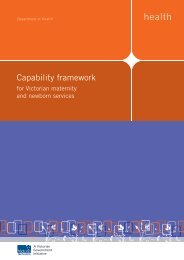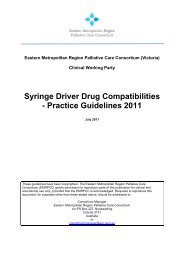Download - South West Alliance of Rural Health
Download - South West Alliance of Rural Health
Download - South West Alliance of Rural Health
You also want an ePaper? Increase the reach of your titles
YUMPU automatically turns print PDFs into web optimized ePapers that Google loves.
ANNUAL REPORT 2011 / 2012
BARWON SOUTH WESTERN REGIONAL INTEGRATED CANCER SERVICE<br />
Annual Report 2011 / 2012
OUR PARTNERS<br />
BSWRICS<br />
GOVERNANCE GROUP<br />
CONTENTS<br />
The following health services have a signed<br />
Memorandum <strong>of</strong> Understanding to form part <strong>of</strong> the<br />
BSWRICS:<br />
• Balmoral Bush Nursing Centre<br />
• Barwon <strong>Health</strong><br />
• Bellarine Community <strong>Health</strong><br />
• Casterton Memorial Hospital<br />
• Colac Area <strong>Health</strong><br />
• Dartmoor Bush Nursing Centre<br />
• Geelong Private Hospital<br />
• Hesse <strong>Rural</strong> <strong>Health</strong> Service<br />
• Heywood <strong>Rural</strong> <strong>Health</strong><br />
• Lorne Community Hospital<br />
• Moyne <strong>Health</strong> Services<br />
• Otway <strong>Health</strong> and Community Services<br />
• Portland District <strong>Health</strong><br />
• <strong>South</strong> <strong>West</strong> <strong>Health</strong>care<br />
• St John <strong>of</strong> God <strong>Health</strong> Care Geelong<br />
• St John <strong>of</strong> God <strong>Health</strong> Care Warrnambool<br />
• Terang and Mortlake <strong>Health</strong> Service<br />
• Timboon and District <strong>Health</strong> Service<br />
• <strong>West</strong>ern District <strong>Health</strong> Service<br />
Other key collaborators<br />
• BreastScreen Geelong<br />
• Regional Palliative Care Consortia<br />
• Pathology Providers<br />
• Imaging Services<br />
• Tissue Bank<br />
• Cancer Council Victoria<br />
• Deakin University<br />
• The Victorian Cancer Agency<br />
• Barwon Medicare Local<br />
• Great <strong>South</strong> Coast Medicare Local<br />
Sandy Morrison<br />
EDSR&I, Barwon <strong>Health</strong> (Chair)<br />
Pr<strong>of</strong> David Ashley<br />
Clinical Director<br />
Kate Morrissy<br />
Program Manager<br />
Felicity Topp<br />
Executive Director, Medical Services, Barwon <strong>Health</strong><br />
John Krygger<br />
CEO, <strong>South</strong> <strong>West</strong> <strong>Health</strong>care<br />
Jim Fletcher<br />
CEO, <strong>West</strong>ern District <strong>Health</strong> Service<br />
Ge<strong>of</strong>f Iles<br />
CEO, Colac Area <strong>Health</strong><br />
Ros Jones<br />
Acting CEO, Portland District <strong>Health</strong><br />
Anne Fairbairn<br />
Department <strong>of</strong> <strong>Health</strong>, Regional Office<br />
Michael Homewood<br />
General Practice Representative<br />
Greg Mitchell<br />
Surgical Representative<br />
Linda <strong>West</strong><br />
CEO, Otway <strong>Health</strong> and Community Services<br />
Rod Lynch<br />
Radiation Oncologist<br />
Terri Hayes<br />
Medical Oncologist Warrnambool<br />
Chairman’s Report 4<br />
About Us 6<br />
Our Region 7<br />
Cancer Incidence 8<br />
Victoria’s Cancer Action Plan 9<br />
Our Community 10<br />
Multidisciplinary Care 12<br />
Cancer Care Coordination 14<br />
Multidisciplinary Cancer Education Network 17<br />
Supportive Care 18<br />
Zara’s Story<br />
(Supportive Care Distress Thermometer) 21<br />
Chemotherapy and Records Management<br />
(CHARM) 22<br />
Evaluation <strong>of</strong> Cancer Outcomes<br />
– Victorian Cancer Outcomes Network 24<br />
Our Financial Report 26<br />
Our Team 28
CHAIRMAN’S REPORT<br />
Welcome to the Barwon <strong>South</strong> <strong>West</strong>ern Regional<br />
Integrated Cancer Service 2011/2012 Annual Report.<br />
As the Chair <strong>of</strong> the governance group I am pleased<br />
to highlight the following key achievements over the<br />
last 12 months.<br />
The newly established Consumer Advisory Group<br />
with representatives from Colac, Warrnambool,<br />
Geelong and Portland brings a new level <strong>of</strong><br />
community engagement to the program. Through<br />
the group, BSWRICS aims to ensure that consumer<br />
perspectives are central to service planning,<br />
infrastructure development and the quality<br />
improvement <strong>of</strong> cancer care in our region.<br />
BSWRICS was pleased to be the only regional<br />
project funded as part <strong>of</strong> the Department <strong>of</strong> <strong>Health</strong>’s<br />
Victorian Cancer Survivorship Program. Commencing<br />
in 2012 the project will run until the end <strong>of</strong> 2013.<br />
For the first time, BSWRICS is partnering with local<br />
primary care organisations in the Barwon Medicare<br />
Local and the Great <strong>South</strong> Coast Medicare Local<br />
to trial a new model <strong>of</strong> care for cancer survivors.<br />
Barwon <strong>Health</strong> in Geelong and <strong>West</strong>ern District<br />
<strong>Health</strong> Service in Hamilton have been nominated<br />
as the two pilot sites. The project team are looking<br />
at a number <strong>of</strong> ways to better meet service needs,<br />
improve health outcomes and enhance the lives <strong>of</strong><br />
cancer survivors and their families. Deakin University<br />
has been engaged to provide a comprehensive<br />
evaluation <strong>of</strong> the project.<br />
We have been delighted to work with the<br />
Warrnambool Multidisciplinary Team to implement<br />
the ‘CANMAP’ database and align processes with<br />
that <strong>of</strong> the Geelong tumour streams. Margaret<br />
Carey was appointed as the <strong>South</strong> <strong>West</strong> <strong>Health</strong>care<br />
multidisciplinary coordinator providing much needed<br />
support for the team locally.<br />
BSWRICS has played a key role in the initiation <strong>of</strong><br />
a medical oncology outreach service from Barwon<br />
<strong>Health</strong> to the <strong>South</strong> <strong>West</strong>. This has resulted in<br />
monthly clinics at Colac, Portland and Hamilton and<br />
has significantly reduced the burden <strong>of</strong> travel for<br />
many <strong>of</strong> our regional patients.<br />
The Cancer Link Nurse Evaluation highlighted the<br />
vital role the nurses play in supporting regional<br />
patients whose cancer journey is more complex than<br />
most by virtue <strong>of</strong> need to travel. It also demonstrated<br />
the important role that the nurses play in improving<br />
communication across organisational boundaries.<br />
Support provided to cancer patients by the Cancer<br />
Link Nurses has been complemented with additional<br />
capacity building across key service providers in<br />
our region. The implementation <strong>of</strong> the ‘Distress<br />
Thermometer’ is close to completion with a total<br />
<strong>of</strong> 40 health pr<strong>of</strong>essionals trained in supportive<br />
care screening. As part <strong>of</strong> the implementation,<br />
supportive care teams have now been established at<br />
Barwon <strong>Health</strong>, <strong>South</strong> <strong>West</strong> <strong>Health</strong>care and <strong>West</strong>ern<br />
District <strong>Health</strong> Service. The team comprises health<br />
pr<strong>of</strong>essionals such as social work, pastoral care, as<br />
well as nursing, and focuses primarily on support<br />
services for the patient.<br />
The Evaluation <strong>of</strong> Cancer Outcomes Project has been<br />
an important partnership for BSWRICS with Cancer<br />
Council Victoria and the Department <strong>of</strong> <strong>Health</strong><br />
Victoria. It was gratifying to complete the project at<br />
the end <strong>of</strong> 2011 with a comprehensive dataset now<br />
collected for 2008 and 2009. The project’s legacy has<br />
provided BSWRICS with a sophisticated model <strong>of</strong> data<br />
collection for all newly diagnosed cancer patients<br />
including detailed information about diagnosis,<br />
prognostic indicators and first line treatment.<br />
More recently, the project team has worked with the<br />
Commonwealth Department <strong>of</strong> <strong>Health</strong> and Ageing to<br />
examine radiotherapy utilisation rates in our region.<br />
Following the evaluation <strong>of</strong> the CHARM electronic<br />
prescribing system, the BSWRICS Governance Group<br />
endorsed the transition <strong>of</strong> funding from BSWRICS to<br />
health services. This is an important step in ensuring<br />
this service innovation becomes mainstream and<br />
embedded in clinical practice for the future.<br />
The first concrete outcomes <strong>of</strong> our successful<br />
Hospital and <strong>Health</strong> Fund (HHF) submission <strong>of</strong> 2010<br />
were realised with the opening <strong>of</strong> the new Cancer<br />
Consulting Suites at <strong>West</strong>ern District <strong>Health</strong> Service<br />
in Hamilton. As part <strong>of</strong> the HHF initiative, BSWRICS<br />
initiated a Chemotherapy Service Planning Project<br />
to assist Portland District <strong>Health</strong> navigate the<br />
complexities <strong>of</strong> establishing a local chemotherapy<br />
service. The plan was five months in its development<br />
and drew upon local expertise and knowledge<br />
through a region wide advisory group. It also<br />
considered the unique context <strong>of</strong> Colac Area <strong>Health</strong><br />
as a potential future chemotherapy service.<br />
A milestone for our program in the past year was the<br />
retirement <strong>of</strong> Maggie Stowers, our Care Coordination<br />
Manager since 2005. As part <strong>of</strong> the foundational<br />
team, her early pioneering work paved the way for<br />
the success <strong>of</strong> the program in later years. She was<br />
integral to the establishment <strong>of</strong> the Cancer Link<br />
Nurse Program and the very successful regional<br />
education network. We also farewelled Dr Lucy<br />
Cuddihy, our Nursing Clinical Director, who has played<br />
an important role in oversight <strong>of</strong> the Program since<br />
2008. I sincerely thank both for their contribution.<br />
Thank you also to the governance group for your<br />
ongoing commitment and support <strong>of</strong> our vision as<br />
well as the many other stakeholders who give their<br />
time freely to assist our work.<br />
In closing, I would also like to recognise the<br />
pr<strong>of</strong>essionalism and skills <strong>of</strong> Kate Morrissy our Program<br />
Manager, David Ashley, our Clinical Director and the<br />
BSWRICS team who work hard to achieve the best<br />
possible outcomes for all our member health services.<br />
Sandy Morrison<br />
Chair<br />
BSWRICS Governance Group<br />
Executive Director<br />
Service Reform and Innovation<br />
Barwon <strong>Health</strong><br />
Pictured above: The new Cancer Consulting Suites at <strong>West</strong>ern District<br />
<strong>Health</strong> Service in Hamilton.<br />
BARWON SOUTH WESTERN REGIONAL INTEGRATED CANCER SERVICE<br />
4 ANNUAL REPORT 2011 / 2012<br />
5
ABOUT US<br />
OUR REGION<br />
Established in 2005, the Barwon <strong>South</strong> <strong>West</strong>ern<br />
Regional Integrated Cancer Service (BSWRICS) is<br />
funded by the Victorian Department <strong>of</strong> <strong>Health</strong> to<br />
facilitate the formal partnership <strong>of</strong> health services<br />
delivering cancer care within the region to improve<br />
service planning, coordination and quality.<br />
BSWRICS is based at Barwon <strong>Health</strong> in Geelong<br />
and is undertaking its role by consulting and<br />
collaborating with regional health partners and<br />
consumers.<br />
Further information is available on our website:<br />
www.swarh2.com.au/bswrics<br />
OUR VISION<br />
Connecting cancer care to provide the best<br />
outcomes and experiences possible for patients<br />
across the region.<br />
OUR MISSION<br />
To improve the experience for all those affected by<br />
cancer in our region by:<br />
• Ensuring patients’, their families’ and carers’<br />
needs are at the centre <strong>of</strong> care;<br />
• Enabling effective local coordination <strong>of</strong> care for<br />
cancer patients;<br />
• Improving relationships and communications<br />
between hospital and primary care providers<br />
within the region to achieve an integrated<br />
platform for cancer care<br />
DESIRED OUTCOMES<br />
• Patients’ cancer journeys are leading to optimal<br />
outcomes and experiences in treatment and<br />
support;<br />
• Collaborative planning is strengthening<br />
relationships, delivering good governance and<br />
the capacity to address needs within the region;<br />
The Barwon <strong>South</strong> <strong>West</strong>ern region <strong>of</strong> Victoria stretches<br />
from the tip <strong>of</strong> the Queenscliff Heads to the border <strong>of</strong> <strong>South</strong><br />
Australia, covering a total area <strong>of</strong> 33,000 square kilometres.<br />
It is home to Victoria’s largest provincial centre, Geelong; and<br />
its population is projected to grow by approximately 26% by<br />
2026, a rate higher than the regional Victoria average with<br />
the current population recorded at 380,000.<br />
Source: Regional Development Victoria.<br />
Glenelg<br />
<strong>South</strong>ern<br />
Grampians<br />
VICTORIA<br />
Greater<br />
Geelong<br />
• Participation in research and innovative<br />
initiatives is ensuring evidence based cancer care<br />
is being provided throughout the region;<br />
• Access to training and technology is enabling the<br />
delivery <strong>of</strong> locally coordinated care<br />
Moyne<br />
Corangamite<br />
Colac<br />
Otway<br />
Surf<br />
Coast<br />
Queenscliff<br />
6<br />
BARWON SOUTH WESTERN REGIONAL INTEGRATED CANCER SERVICE<br />
ANNUAL REPORT 2011 / 2012<br />
7
CANCER INCIDENCE<br />
VICTORIA’S CANCER ACTION PLAN 2008-2012<br />
Cancer is the leading cause <strong>of</strong> death in Victoria.<br />
Approximately 500 Victorians are diagnosed with<br />
cancer each week. The highest incidences <strong>of</strong> cancer<br />
occur within the lung, bowel, prostate and breast<br />
tumour streams. In 2010, 28,363 Victorians were<br />
diagnosed with malignant cancer and 10,673 died<br />
from cancer. The Barwon <strong>South</strong> <strong>West</strong>ern Region<br />
accounts for approximately 8% <strong>of</strong> cancer in the<br />
state. The combined incidence for all cancers in 2010<br />
for the Barwon <strong>South</strong> <strong>West</strong> was 2,312; total number<br />
<strong>of</strong> deaths from cancer 941.<br />
Source: Cancer Council Victoria.<br />
Victoria’s Cancer Action Plan 2008–2011 (VCAP) was<br />
released in December 2008. The plan will ensure the<br />
cancer prevention and care Victorians receive is the<br />
best it can be, informed by the latest research and<br />
state-<strong>of</strong>-the-art technologies.<br />
The Cancer Action Plan outlines a medium-term vision<br />
for cancer reform that will <strong>of</strong>fer standardised and<br />
high quality cancer care to all Victorians, regardless<br />
<strong>of</strong> whether they live in metropolitan, regional or rural<br />
Victoria. This is a comprehensive action plan with<br />
measurable targets across four key action areas.<br />
ACTION AREA 1<br />
ACTION AREA 2<br />
Number <strong>of</strong> new cases<br />
2500<br />
2000<br />
1500<br />
1000<br />
500<br />
0<br />
BARWON SOUTH WESTERN REGIONAL INTEGRATED CANCER SERVICE<br />
8 ANNUAL REPORT 2011 / 2012<br />
1982<br />
1983<br />
1984<br />
1985<br />
1986<br />
1987<br />
1988<br />
1989<br />
1990<br />
1991<br />
1992<br />
1993<br />
1994<br />
1995<br />
1996<br />
1997<br />
1998<br />
1999<br />
2000<br />
2001<br />
2002<br />
2003<br />
2004<br />
2005<br />
2006<br />
2007<br />
2008<br />
2009<br />
2010<br />
Female<br />
Male<br />
• Total<br />
PRIORITY 1 Reduce the prevalence <strong>of</strong> established risk<br />
factors for cancer in the Victorian population<br />
PRIORITY 2 Increase participation rates in<br />
population-based cancer screening programs<br />
PRIORITY 3 Increase access to genetic<br />
screening and new diagnostic technology<br />
ACTION AREA 3<br />
PRIORITY 1 Improve cancer service<br />
capacity across Victoria<br />
PRIORITY 2 Improve the quality <strong>of</strong> cancer<br />
services through the consistent implementation<br />
and monitoring <strong>of</strong> evidence-based care<br />
PRIORITY 3 Improve access to cancer diagnostic<br />
and treatment equipment and ensure a sustainable<br />
cancer workforce<br />
Source: Victoria’s Cancer Action Plan 2008-2011<br />
PREVENTION<br />
TREATMENT<br />
Patient<br />
Centred<br />
Care<br />
PRIORITY 1 Sustain and strengthen Victoria’s<br />
leadership role in linking cancer research to clinical<br />
outcomes within Australia<br />
PRIORITY 2 Invest in transitional research and<br />
develop partnerships with industry<br />
PRIORITY 3 Further develop institutional<br />
structures, platforms and support<br />
systems to facilitate cancer research<br />
and its effective translation into<br />
clinical practice in Victoria<br />
RESEARCH<br />
ACTION AREA 4<br />
PRIORITY 1 Create better experiences<br />
for cancer patients and carers<br />
PRIORITY 2 Ensure the needs <strong>of</strong><br />
adolescent and young adults with cancer are<br />
addressed and that long-term effects <strong>of</strong> treatment<br />
for survivors <strong>of</strong> childhood cancers are managed<br />
PRIORITY 3 Increase capacity <strong>of</strong> palliative care services<br />
to provide care for patients in the place <strong>of</strong> their choice<br />
SUPPORT<br />
9
OUR COMMUNITY<br />
Our commitment to consumer participation has<br />
never been more evident than in the last 12 months<br />
with the establishment <strong>of</strong> our region-wide Consumer<br />
Advisory Group. The group includes representatives<br />
from Colac, Portland, Warrnambool and Geelong and<br />
range in age from 30-70 years.<br />
In preparation for their role as consumers, the<br />
<strong>Health</strong> Issue Centre provided an in-house training<br />
session. The group has subsequently met three<br />
times and provided input into a range <strong>of</strong> BSWRICS<br />
improvement initiatives.<br />
Specifically they have:<br />
• Reviewed the Consumer Multidisciplinary Care<br />
Brochure<br />
• Provided input into the Survivorship Project<br />
initiative<br />
• Identified the need for general information packs<br />
to be available for patients travelling to Geelong<br />
from the region.<br />
Marilyn Dolling (pictured right) has a long history <strong>of</strong><br />
involvement with BSWRICS. The team was therefore<br />
delighted when she agreed to chair the group.<br />
Marilyn is also part <strong>of</strong> the Barwon <strong>Health</strong> Consumer<br />
Advisory Committee and currently sits on Barwon<br />
<strong>Health</strong>’s Consumer Centred Care Committee. She has<br />
also been involved at a State level on the CanNET<br />
project team and Cancer Voices Victoria.<br />
As outlined in our Consumer Participation Plan in<br />
2011, the Consumer Advisory Group is a key strategy<br />
aimed at:<br />
• Increasing relevance <strong>of</strong> BSWRICS’ work to the<br />
needs <strong>of</strong> consumers in our region<br />
• Developing a culture <strong>of</strong> consumer and BSWRICS<br />
partnership<br />
• Utilising consumer perspectives to inform<br />
strategies for cancer service improvement by<br />
identifying consumers’ priorities, expectations<br />
and needs<br />
• Seeking advice on ways to improve the cancer<br />
experience for patients and carers<br />
• Building capacity <strong>of</strong> consumers to actively<br />
participate in design, planning and evaluation <strong>of</strong><br />
cancer services.<br />
There have been two consumers appointed to the<br />
Board <strong>of</strong> the Survivorship Pilot both <strong>of</strong> whom who<br />
have undertaken the <strong>Health</strong> Issues Centre Training.<br />
We look forward to their continued involvement<br />
particularly in the development <strong>of</strong> the new cancer<br />
service facilities across our region.<br />
Our commitment to consumer participation<br />
has never been more evident than in the<br />
last 12 months with the establishment <strong>of</strong><br />
our region wide Consumer Advisory Group.<br />
10<br />
BARWON SOUTH WESTERN REGIONAL INTEGRATED CANCER SERVICE<br />
ANNUAL REPORT 2011 / 2012<br />
Marilyn Dolling, Chair, Consumer Advisory Group<br />
11
MULTIDISCIPLINARY CARE<br />
The BSWRICS Multidisciplinary Care Program<br />
has seen considerable progress since the last<br />
reporting period.<br />
For the past 12 months we have focused on<br />
expanding our successful Multidisciplinary Care<br />
Meeting (MDM) Program within the region. This has<br />
included many visits to Warrnambool to further<br />
develop and strengthen the relationship with our<br />
regional colleagues. In this time, we have developed<br />
and approved a meeting Terms <strong>of</strong> Reference,<br />
streamlined meeting processes and appointed<br />
Margaret Carey as the .4EFT Multidisciplinary<br />
Meeting Coordinator. As a registered nurse, Margaret<br />
brings with her significant knowledge and experience<br />
<strong>of</strong> surgical services within the Warrnambool area.<br />
For the first time we have been able to collect<br />
data on the Warrnambool Multidisciplinary Cancer<br />
Care Meeting which indicated 145 cases had been<br />
presented at this meeting. Combined, this has<br />
provided a growth <strong>of</strong> almost 20% in our total figures<br />
over the financial year.<br />
The number <strong>of</strong> cases listed for discussion at the<br />
Geelong meetings increased by 91 as a direct result<br />
<strong>of</strong> improved efficiency in meeting processes.<br />
Considerable work has also been undertaken to<br />
support the establishment <strong>of</strong> the Supportive Care<br />
Team (SCT) meeting at <strong>South</strong> <strong>West</strong> <strong>Health</strong>care. This<br />
is based on the SCT meetings which are held at<br />
Barwon <strong>Health</strong>, Geelong.<br />
Behind the scenes, we worked in conjunction with<br />
s<strong>of</strong>tware developers on a major upgrade <strong>of</strong> the<br />
CANMAP database used to capture and distribute<br />
information in relation to the MDM program.<br />
The website upgrade incorporates the Victorian<br />
MDM consensus dataset. Arrangements are now in<br />
place with the Regional <strong>Health</strong> Services to receive<br />
and include meeting recommendations for patients<br />
discussed at a BSWRICS MDM in their central<br />
medical records. A new television and updated video<br />
conferencing equipment were also installed in the<br />
Geelong MDM meeting room during the year.<br />
As part <strong>of</strong> the Victorian Integrated Cancer Services<br />
MDM Coordinators group, and in collaboration<br />
with the CanNET II project team, we have contributed<br />
toward the content <strong>of</strong> the statewide MDM<br />
directory and review <strong>of</strong> the multidisciplinary team<br />
meeting toolkit.<br />
We wish to acknowledge and thank our outgoing<br />
Meeting Chairs for 2011: Mr Karl Braslis (Urology),<br />
Mr George Kir<strong>of</strong>f (Upper GI) and Dr Chris Steinfort<br />
(Lung). And we welcome the new incumbents: Mr<br />
Ken Chao (Upper GI), Mr Paul Kearns (Urology) and<br />
Dr Madhu Singh (Lung).<br />
Thanks must also go to the committed clinicians<br />
that attend our MDMs, in particular our diagnostic<br />
colleagues – Barwon Medical Imaging, Geelong<br />
Medical Imaging, Lake Imaging, PathCare, AnatPath,<br />
and the Barwon Medicare Local GP representatives.<br />
Planning for the next reporting period is underway<br />
and will include the:<br />
• Establishment and commencement <strong>of</strong> a regional<br />
Melanoma/Skin Cancer MDM<br />
• Provision <strong>of</strong> continued support toward the<br />
development <strong>of</strong> the Hamilton Multidisciplinary<br />
Cancer Review meeting, including the<br />
appointment <strong>of</strong> a .2EFT MDM Coordinator<br />
• Ongoing review <strong>of</strong> the imaging collection<br />
processes for Geelong meetings<br />
• Review <strong>of</strong> Terms <strong>of</strong> Reference and meeting<br />
guidelines for all MDMs.<br />
I would personally like to pass on my thanks to<br />
Bianca Maher and Margaret Carey for the valuable<br />
assistance they provide to the MDM teams with their<br />
thorough and efficient preparation <strong>of</strong> each MDM.<br />
Working together as a cohesive team has ensured<br />
the continued growth <strong>of</strong> the program.<br />
BARWON SOUTH WESTERN REGION<br />
MULTIDISCIPLINARY CASE DISCUSSIONS 2006–2012<br />
1400<br />
1200<br />
1000<br />
800<br />
600<br />
400<br />
200<br />
0<br />
399<br />
2006–2007<br />
544<br />
2007–2008<br />
2008–2009<br />
715 823 1033<br />
2009–2010<br />
2010–2011<br />
2011–2012<br />
Shayne Ryan,<br />
Regional Multidisciplinary Care Manager<br />
1269<br />
12<br />
BARWON SOUTH WESTERN REGIONAL INTEGRATED CANCER SERVICE<br />
ANNUAL REPORT 2011/ 2012<br />
13
CANCER CARE COORDINATION<br />
The key focus in care coordination over the past 12<br />
months has been the implementation <strong>of</strong> the Cancer<br />
Link Nurse Evaluation.<br />
The Cancer Link Nurse (CLN) Program commenced in<br />
2010, following a six-month pilot project at Colac Area<br />
<strong>Health</strong>. This was followed by appointment <strong>of</strong> Cancer<br />
Link Nurses at <strong>West</strong>ern District <strong>Health</strong> Service,<br />
Portland District <strong>Health</strong>, <strong>South</strong> <strong>West</strong> <strong>Health</strong>care and<br />
Barwon <strong>Health</strong>. The five nurses work together to:<br />
• Provide information and emotional support to<br />
rural patients following a cancer diagnosis<br />
• Facilitate early referral to supportive care<br />
services<br />
• Improve coordination <strong>of</strong> care and travel<br />
assistance for patients receiving treatment<br />
outside their local area<br />
• Streamline communication between multiple<br />
care providers and transcend health services<br />
boundaries<br />
• Act as a local source <strong>of</strong> expertise and knowledge<br />
in supportive care<br />
• Identify cancer service improvements.<br />
As a new and innovative model <strong>of</strong> care for cancer<br />
patients the evaluation sought to:<br />
• Describe the model and the context within which<br />
it operates<br />
• Identify the extent to which the program met the<br />
original aims<br />
• Identify positive and negative outcomes arising<br />
from the program for stakeholders<br />
• Identify the benefits and costs <strong>of</strong> sustaining<br />
the program<br />
• Provide recommendations about the strategic<br />
direction <strong>of</strong> the program, including opportunities<br />
for improvement.<br />
There were three key components <strong>of</strong> the evaluation:<br />
• A survey <strong>of</strong> patients which aimed to understand<br />
the experience <strong>of</strong> patients, clinicians, health<br />
service managers and the Cancer Link Nurses<br />
themselves. In total 118 patients, 55 clinicians, 12<br />
managers and five Cancer Link Nurses responded<br />
to the survey<br />
• A de-identified analysis <strong>of</strong> the types <strong>of</strong> patients<br />
that had been seen by the Cancer Link Nurses,<br />
the reason for their presentation and the way the<br />
nurses had assisted with their cancer journey<br />
• A review <strong>of</strong> all their monthly reports over the<br />
evaluation period.<br />
The positions are strongly supported by patients<br />
and clinicians as indicated in the snapshot <strong>of</strong> results<br />
(opposite).<br />
HAS THE CLN PROGRAM IMPROVED COMMUNICATION<br />
AND INFORMATION FLOW BETWEEN YOU AND OTHER<br />
CANCER CARE CLINICIANS/SERVICES<br />
67.3%<br />
(33)<br />
OVERALL, HOW SATISFIED ARE YOU WITH THE CLN<br />
SUPPORT YOU WERE PROVIDED<br />
87.7%<br />
(107)<br />
1.6%<br />
(2)<br />
18.4%<br />
(9)<br />
10.7%<br />
(13)<br />
14.3%<br />
(7)<br />
Yes<br />
•<br />
No<br />
Don’t know<br />
•<br />
Satisfied<br />
Neither satisfied<br />
•<br />
nor dissatisfied<br />
Not satisfied<br />
An outcome <strong>of</strong> the Cancer Link Nurse (CLN)<br />
Evaluation was the recognition that the Cancer Link<br />
Nurses are in a unique position to identify cancer<br />
service improvements. This is highlighted in the<br />
following two examples:<br />
A patient living in a rural area outside <strong>of</strong> Colac was<br />
having to travel into Colac on the day before their<br />
chemotherapy treatment in Geelong to have blood<br />
tests. An hour long trip in the car in consecutive<br />
days was becoming increasingly difficult for the<br />
patient due to feeling unwell. The Barwon <strong>Health</strong><br />
CLN identified the patient’s distress and contacted<br />
the Colac CLN to discuss an alternative process. As a<br />
result, the Colac CLN liaised with the local pathology<br />
service and the treating clinicians at Barwon <strong>Health</strong><br />
and organised the blood tests to be performed on<br />
the way to Geelong. This eliminated the need for<br />
consecutive trips and reduce the travel burden and<br />
anxiety for the patient.<br />
The Warrnambool CLN identified minimal care<br />
coordination for patients from <strong>South</strong> Australia<br />
having treatment in Warrnambool. She contacted the<br />
health service in Mt Gambier and spoke to the care<br />
coordinator. Subsequently, a new referral pathway<br />
was established ensuring adequate referrals to local<br />
supportive care services for these patients when<br />
returning home.<br />
14<br />
BARWON SOUTH WESTERN REGIONAL INTEGRATED CANCER SERVICE<br />
ANNUAL REPORT 2011 / 2012<br />
15
MULTIDISCIPLINARY CANCER EDUCATION NETWORK<br />
The Multidisciplinary Cancer Education Network was<br />
established by BSWRICS in 2005. The network is an<br />
authorised provider <strong>of</strong> courses endorsed by the Royal<br />
College <strong>of</strong> Nursing, Australia, providing monthly<br />
forums for clinicians. This means participants receive<br />
formal recognition <strong>of</strong> the education as part <strong>of</strong> their<br />
mandatory pr<strong>of</strong>essional development requirements.<br />
The network also notifies and circulates education<br />
opportunities and information to Geelong and<br />
regional groups. In addition, BSWRICS also <strong>of</strong>fers<br />
sponsorship grants for regional clinicians to attend<br />
cancer education across Victoria and Australia.<br />
BSWRICS is committed to continuing the<br />
Multidisciplinary Cancer Education Program that was<br />
initiated and led by Maggie Stowers until she left in<br />
June this year.<br />
The attendees cover a wide range <strong>of</strong> disciplines<br />
including oncology and palliative care nurses at<br />
Barwon <strong>Health</strong> and St John <strong>of</strong> God Hospital, medical,<br />
allied health, pharmacy and clinical trial clinicians.<br />
The 2011-2012 education forums have been well<br />
received throughout the year and we are grateful<br />
to specialist clinicians from Barwon <strong>Health</strong> who are<br />
willing to share their time and expertise. A number <strong>of</strong><br />
presenters from Melbourne have allowed us to cover<br />
a wider range <strong>of</strong> topics presenting forums on familial<br />
cancer services and fertility preservation.<br />
Also in collaboration with local clinicians and<br />
consumers, the Ontrack Team at Peter Mac provided<br />
a workshop on the treatment <strong>of</strong> Adolescent and<br />
Young Adults for cancer. This was part <strong>of</strong> the<br />
Victorian and Tasmanian Youth Cancer Network<br />
Project 2011-2012, and these sessions will become a<br />
regular feature <strong>of</strong> the program in the future.<br />
These forums are free to participants and a light<br />
supper is provided by BSWRICS. The topics covered<br />
in 2011-2012 are as follows:<br />
• Management <strong>of</strong> renal cancer<br />
• Surgical developments in colorectal cancer<br />
• Supportive care update<br />
• Gynaecological cancer update<br />
• Oncology pharmacy<br />
• Familial cancer services update<br />
• Pancreatic cancer update<br />
• Radiotherapy update<br />
• Breast cancer and pregnancy<br />
CANCER EDUCATION FORUM ATTENDANCE<br />
– GEELONG & REGIONAL<br />
Number <strong>of</strong> attendees<br />
400<br />
350<br />
300<br />
250<br />
200<br />
150<br />
100<br />
50<br />
0<br />
2009/<br />
2010<br />
12<br />
314<br />
2010/<br />
2011<br />
294<br />
2011/<br />
2012<br />
37<br />
55 345<br />
Geelong<br />
• Regional<br />
16<br />
Dr Mustafa Khasraw, Medical Oncologist at<br />
Barwon <strong>Health</strong> provided an update on pancreatic<br />
BARWON SOUTH WESTERN REGIONAL INTEGRATED CANCER SERVICE<br />
ANNUAL REPORT 2011 / 2012 cancer at the April 2012 Education Forum<br />
17
Cancer Link Nurse Kirsty Rollason<br />
SUPPORTIVE CARE<br />
The supportive care screening tool, called the<br />
Distress Thermometer, has now been implemented<br />
at the Andrew Love Cancer Centre (ALCC) medical<br />
oncology and the radiotherapy department. More<br />
than 700 patients were screened for supportive<br />
care needs from June 2011 to June 2012. Training <strong>of</strong><br />
clinicians on the inpatient oncology ward at Barwon<br />
<strong>Health</strong> has commenced and will be completed by<br />
October 2012.<br />
Seventy health care clinicians across Warrnambool,<br />
Hamilton and Portland have attended education<br />
forums on supportive care screening. An additional<br />
40 clinicians in total have now completed training on<br />
the Distress Thermometer about using the tool and<br />
conducting a follow-up interview with the patient on<br />
their supportive care needs.<br />
There has been a strong focus on building<br />
capacity at the <strong>South</strong> <strong>West</strong> <strong>Health</strong> Services with<br />
the implementation <strong>of</strong> the Distress Thermometer<br />
completed at Hamilton Hospital and in progress at<br />
the other sites.<br />
each <strong>of</strong> those hospitals. The Supportive Care Team<br />
is made up <strong>of</strong> different disciplines at each regional<br />
hospital and may include social work, pastoral care,<br />
nursing, medical, pharmacy, psychology, diabetes<br />
educator or palliative care. This will ensure regional<br />
cancer patients’ supportive care needs are identified<br />
and assessed, and that they are <strong>of</strong>fered timely access<br />
to support.<br />
A new policy for Supportive Cancer Services was<br />
endorsed at Barwon <strong>Health</strong> providing a commitment<br />
to ensuring patients are screened for supportive care<br />
needs as part <strong>of</strong> their routine care pathway.<br />
BSWRICS established a new volunteer role for<br />
restocking all <strong>of</strong> the cancer information resources<br />
at the Andrew Love Cancer Centre, on the inpatient<br />
oncology ward, and the accommodation units.<br />
Melinda Williams<br />
Supportive Care Project Manager<br />
Following the successful establishment <strong>of</strong> a<br />
Multidisciplinary Supportive Care Team meeting<br />
at Barwon <strong>Health</strong>, this model has now been<br />
implemented at <strong>South</strong> <strong>West</strong> <strong>Health</strong>care and<br />
<strong>West</strong>ern District <strong>Health</strong> Service. These meetings<br />
are facilitated by BWSRICS, the regional cancer link<br />
nurses and involve the new MDM coordinator roles at<br />
18<br />
BARWON SOUTH WESTERN REGIONAL INTEGRATED CANCER SERVICE<br />
ANNUAL REPORT 2011 / 2012 19
ZARA’S STORY<br />
(SUPPORTIVE CARE DISTRESS THERMOMETER)<br />
Waurn Ponds resident Zara White, a breast cancer<br />
survivor and mother <strong>of</strong> two, completed the Distress<br />
Thermometer when she first attended the Andrew<br />
Love Cancer Centre for chemotherapy treatment in<br />
2011. Zara said the Distress Thermometer enabled<br />
her to identify and communicate her concerns.<br />
“The Distress Thermometer helped alert me to the<br />
areas where I needed more support,” she said.<br />
“The way in which the emotional concerns were<br />
listed on the screening tool as feelings made it<br />
easier for me to identify my concerns. I felt it directly<br />
facilitated a referral to the psychologist and the<br />
McGrath Breast Care Nurse. It also meant I was linked<br />
into the ‘Look Good Feel Better’ program and the<br />
Lymphoedema Clinic.<br />
“Other services like the Lymphoedema Clinic and<br />
education sessions on wigs and makeup empowered<br />
me to take care <strong>of</strong> myself.<br />
“Having direct access to the psychologist through<br />
the Andrew Love Cancer Centre played an important<br />
role in helping me to cope better with my cancer<br />
journey. The psychologist was familiar with the<br />
notions surrounding palliative care and other issues<br />
which meant I did not need to explain my story again.<br />
Completing the tool made me feel like the staff<br />
cared about the way I was feeling and what I was<br />
going through.”<br />
“The McGrath Breast Care Nurse provided me with<br />
emotional support and information which allayed<br />
my concerns.<br />
20<br />
BARWON SOUTH WESTERN REGIONAL INTEGRATED CANCER SERVICE<br />
ANNUAL REPORT 2011 / 2012<br />
Cancer survivor Zara White with Supportive<br />
Care project manager Melinda Willliams<br />
21
CHEMOTHERAPY AND RECORDS MANAGEMENT<br />
(CHARM)<br />
CHARM is an electronic regional oncology system<br />
which has been used to provide chemotherapy<br />
treatment to cancer patients attending Barwon<br />
<strong>Health</strong> since 2007 and the <strong>West</strong>ern District <strong>Health</strong><br />
Service (WDHS) since 2008, <strong>South</strong> <strong>West</strong> <strong>Health</strong>care<br />
(SWH) since 2010 and St John <strong>of</strong> God Hospital<br />
Pharmacy in Geelong since 2011.<br />
CHARM facilitates the use <strong>of</strong> consistent evidence<br />
based oncology and haematology clinical treatment<br />
pathways for electronic prescribing <strong>of</strong> chemotherapy.<br />
It supports safety by ensuring records are legible for<br />
pharmacy and nursing staff. Using one integrated<br />
oncology database across the region allows patient<br />
information to be shared, improving care coordination<br />
and also supporting patient involvement<br />
in clinical trials.<br />
In November 2010, the BSWRICS Governance Group<br />
recommended an evaluation <strong>of</strong> CHARM across the<br />
Barwon <strong>South</strong> <strong>West</strong>. The purpose <strong>of</strong> the evaluation<br />
was to consider whether CHARM was meeting users’<br />
needs and to inform decision making leading up to<br />
Barwon <strong>Health</strong>’s contract renewal in June 2012.<br />
The evaluation team concluded that CHARM was<br />
meeting the needs <strong>of</strong> Barwon <strong>Health</strong> and the other<br />
sites and a new contract was negotiated with<br />
unlimited licenses. It is expected this will allow for<br />
the expansion <strong>of</strong> CHARM into other sites across<br />
the region.<br />
Following the evaluation, the BSWRICS Governance<br />
Group agreed to transition CHARM from project<br />
based funding (through BSWRICS) to integration<br />
with health services’ operational responsibility.<br />
This change aims to build local ownership and ensure<br />
sustainability for the future.<br />
Additional quality management <strong>of</strong> CHARM pathways<br />
has also been established over the last 12 months.<br />
This involves annual reviews <strong>of</strong> each tumour stream<br />
by the medical and radiation oncology teams to<br />
ensure the treatments are current best practice.<br />
Marilyn Wendt<br />
CHARM Project Officer<br />
The evaluation included:<br />
• A review <strong>of</strong> CHARM as well as alternative<br />
systems<br />
• A survey <strong>of</strong> CHARM users at Barwon <strong>Health</strong> was<br />
conducted to ascertain needs across the various<br />
pr<strong>of</strong>essions<br />
• A site visit to Warrnambool and Hamilton to<br />
consult with clinicians and current satisfaction<br />
levels with CHARM<br />
22<br />
Patient Tom Sutherland and Barwon <strong>Health</strong><br />
BARWON SOUTH WESTERN REGIONAL INTEGRATED CANCER SERVICE<br />
ANNUAL REPORT 2011 / 2012 nurse S<strong>of</strong>ia Delgiudice<br />
23
EVALUATION OF CANCER OUTCOMES<br />
– VICTORIAN CANCER OUTCOMES NETWORK<br />
The Evaluation <strong>of</strong> Cancer Outcomes (ECO) project<br />
was a partnership between BSWRICS, Cancer Council<br />
Victoria and the Department <strong>of</strong> <strong>Health</strong>. The overall<br />
objective was to establish a sustainable model <strong>of</strong><br />
data collection for all newly diagnosed patients<br />
across our region.<br />
Since inception in 2008 we have successfully<br />
implemented a standardised method <strong>of</strong> collecting<br />
stage at diagnosis, prognostic indicators, first line<br />
treatment and subsequent outcomes. This provides<br />
an extension to the existing Victorian Cancer<br />
Registry (VCR) population based dataset.<br />
Throughout 2012 we established a further link with<br />
the Victorian Department <strong>Health</strong> and Commonwealth<br />
Department <strong>of</strong> <strong>Health</strong> and Ageing to investigate<br />
patterns in those not presenting for radiotherapy in<br />
the Barwon <strong>South</strong> <strong>West</strong>ern Region and to calculate<br />
actual radiotherapy rates in this region.<br />
Existing methodology uses an approximation from<br />
state-wide data with no direct link to complete<br />
patient information. Our study improved on this by<br />
calculating actual utilisation <strong>of</strong> radiotherapy rates<br />
using the Victorian Cancer Outcomes Network<br />
(VCON) population-based dataset for BSWRICS.<br />
Univariate analysis found a pattern towards those<br />
without radiotherapy being older and with greater<br />
distance to travel. However, the majority <strong>of</strong> clinical<br />
decisions are based on tumour stage.<br />
Prostate, breast, rectum and lung tumour sites were<br />
selected for more detailed analysis across tumour<br />
stage. The highest rate <strong>of</strong> radiotherapy was found<br />
in Stage III categories for lung, breast and rectal<br />
tumours. There was a trend towards an older age<br />
group in those without radiotherapy for the breast,<br />
lung and rectal tumour streams. Longer distances<br />
to travel were found in those without radiotherapy<br />
for breast and prostate. However, further links<br />
to multidisciplinary meeting outcomes, surgery<br />
and chemotherapy data may identify important<br />
c<strong>of</strong>ounders.<br />
RADIOTHERAPY UTILISATION RATES FOR THE<br />
BARWON SOUTH WESTERN REGIONAL INTEGRATED<br />
CANCER SERVICE FOR PATIENTS DIAGNOSED WITH<br />
PRIMARY TUMOURS IN 2009<br />
Table 1<br />
BSWRICS<br />
Patients receiving radiotherapy<br />
(Utilisation Rate %)<br />
Overall 488 (27.5%)<br />
Head and neck 27 (62.8%)<br />
Oesophagus 22 (62.9)<br />
Stomach 9 (23.1)<br />
Colon 4 (2.2)<br />
Rectum 34 (34.7)<br />
Anus 6 (85.7)<br />
Liver 1 (5.9)<br />
Gallbladder 0 (0.0)<br />
Pancreas 5 (10.9)<br />
Lung 83 (52.2)<br />
Melanoma 10 (8.6)<br />
Breast 125 (56.1)<br />
Gynaecological 9 (15.5)<br />
Prostate 71 (21.2)<br />
In addition, the VCON dataset has been utilised to:<br />
• Inform service planning across region<br />
• Support funding submissions<br />
• Support Clinical Audit<br />
• Support feasibility <strong>of</strong> Clinical Trials<br />
• Understand pathways for patients across health<br />
services and public and private sectors across<br />
our region<br />
Further development <strong>of</strong> the data collection<br />
methodology has resulted in a consolidated database<br />
encompassing numerous efficiencies.<br />
Leigh Matheson<br />
<strong>Health</strong> Information Manager<br />
Data, Quality and Research<br />
Assoc. Pr<strong>of</strong> Margaret Henry<br />
Data Analyst<br />
Data, Quality and Research<br />
Testis 0 (0.0)<br />
Renal 3 (6.5)<br />
Bladder 8 (15.1)<br />
Central Nervous System 13 (65.0)<br />
Lymphoma 19 (20.4)<br />
Myeloma 7 (26.9)<br />
Leukaemia 4 (9.5)<br />
Thyroid 1 (5.3)<br />
Other 27 (27.8)<br />
24<br />
BARWON SOUTH WESTERN REGIONAL INTEGRATED CANCER SERVICE<br />
ANNUAL REPORT 2011 / 2012 25
FINANCIAL REPORT<br />
FOR THE PERIOD 1 JULY 2011 TO 30 JUNE 2012<br />
OUR PRIORITIES FOR 2013<br />
REVENUE $<br />
Leadership and ICS Management $308,963.00<br />
Clinical network development $185,379.00<br />
Multidisciplinary care coordination $185,379.00<br />
Australian Better <strong>Health</strong> Initiative $271,884.00<br />
Psychosocial care development $123,585.00<br />
Quality monitoring and support $98,869.00<br />
Other DH grants – CanNET II $15,000.00<br />
Accumulated interest<br />
REVENUE TOTAL $1,189,060.00<br />
EXPENDITURE $<br />
Administrative salaries $593,838.00<br />
Contract/other agency $211,060.00<br />
Computer s<strong>of</strong>tware $91,014.00<br />
Administrative and <strong>of</strong>fice supplies $58,986.00<br />
Education/MDM operation costs $23,419.00<br />
Motor vehicles and travel $13,189.00<br />
Capital and equipment $10,172.00<br />
Corporate management charge by<br />
host agency<br />
$153,750.00<br />
Conference and sponsorship $32,065.00<br />
Project expenses $9,935.00<br />
TOTAL EXPENSES $1,197,428.00<br />
• The completion <strong>of</strong> Supportive Care Screening<br />
training for clinicians on the inpatient oncology<br />
ward (Barwon <strong>Health</strong>), Warrnambool Base<br />
Hospital, Portland Hospital<br />
• Commence training clinicians in supportive care<br />
screening at regional private hospitals<br />
• Support ongoing implementation <strong>of</strong> the SCT<br />
MDM’s at the regional hospitals<br />
• Development <strong>of</strong> the new BSWRICS Strategic Plan<br />
2013-2016<br />
• Identification <strong>of</strong> a sustainable funding stream for<br />
the Cancer Link Nurse Program<br />
• Exploration <strong>of</strong> more efficient models <strong>of</strong><br />
medical oncology outreach through tele-health<br />
technologies<br />
• Implementation <strong>of</strong> the survivorship project at<br />
Barwon <strong>Health</strong> and <strong>West</strong>ern District <strong>Health</strong><br />
Service<br />
• Expansion <strong>of</strong> CHARM into Barwon <strong>South</strong> <strong>West</strong><br />
private hospitals<br />
• Integration <strong>of</strong> the Evaluation <strong>of</strong> Cancer<br />
Outcomes Project with clinical research, quality<br />
improvement and new data related projects<br />
• Establishment <strong>of</strong> a regional melanoma/skin<br />
cancer multidisciplinary meeting<br />
• Consolidation <strong>of</strong> the Supportive Care Meetings at<br />
the regional hospitals<br />
• Completion <strong>of</strong> Supportive Care Screening<br />
training for clinicians on the inpatient oncology<br />
ward (Barwon <strong>Health</strong>), <strong>South</strong> <strong>West</strong> <strong>Health</strong>care<br />
and Portland District <strong>Health</strong><br />
• Piloting <strong>of</strong> the Cancer Patient Experience Survey<br />
at Barwon <strong>Health</strong><br />
• Ensuring opportunities for consumers to provide<br />
input and inform the development <strong>of</strong> new cancer<br />
facilities across the region<br />
• Further development and refinement <strong>of</strong><br />
mechanisms for engaging consumer perspectives<br />
in the BSWRICS work program<br />
• Establishment <strong>of</strong> the clinical review<br />
multidisciplinary meeting at <strong>West</strong>ern District<br />
<strong>Health</strong> Service<br />
26<br />
BARWON SOUTH WESTERN REGIONAL INTEGRATED CANCER SERVICE<br />
ANNUAL REPORT 2011 / 2012<br />
27
OUR TEAM<br />
Sandy Morrison<br />
Chair, BSWRICS Governance<br />
Group<br />
Pr<strong>of</strong>essor David Ashley<br />
Clinical Director Medical<br />
BSWRICS<br />
Kate Morrissy<br />
Program Manager<br />
Melinda Williams<br />
Supportive Care Project<br />
Manager<br />
Shayne Ryan<br />
Regional Multidisciplinary<br />
Care Manager<br />
Marilyn Wendt<br />
CHARM Project Officer<br />
Carmel Winstanley<br />
Administration Officer<br />
(Publications)<br />
Bianca Maher<br />
Administration Support<br />
Leigh Matheson<br />
<strong>Health</strong> Information Manager<br />
Data, Quality & Research<br />
Margaret Henry<br />
Data Analyst<br />
Data Quality and Research<br />
Kate Sch<strong>of</strong>ield<br />
Project Manager<br />
BSWRICS Survivorship Project<br />
Donna Lever<br />
Barwon <strong>Health</strong><br />
Survivorship Nurse<br />
Margaret Carey<br />
<strong>South</strong> <strong>West</strong> <strong>Health</strong>care<br />
Multidisciplinary Care Coordinator<br />
The BSWRICS team thanks Zara White<br />
and Marilyn Dolling for their valued<br />
contributions to this report.<br />
Sharon Petering<br />
Warrnambool Cancer<br />
Link Nurse<br />
Kirsty Rollason<br />
Barwon <strong>Health</strong><br />
Cancer Link Nurse<br />
Marg Vesey<br />
Colac Cancer Link Nurse<br />
Elaine Norton<br />
Portland Cancer Link Nurse<br />
Jane Sharp<br />
Hamilton Cancer Link Nurse<br />
Design by<br />
28<br />
BARWON SOUTH WESTERN REGIONAL INTEGRATED CANCER SERVICE<br />
ANNUAL REPORT 2011 / 2012
This report is printed<br />
on paper produced from<br />
FSC certified and ECF pulp.



